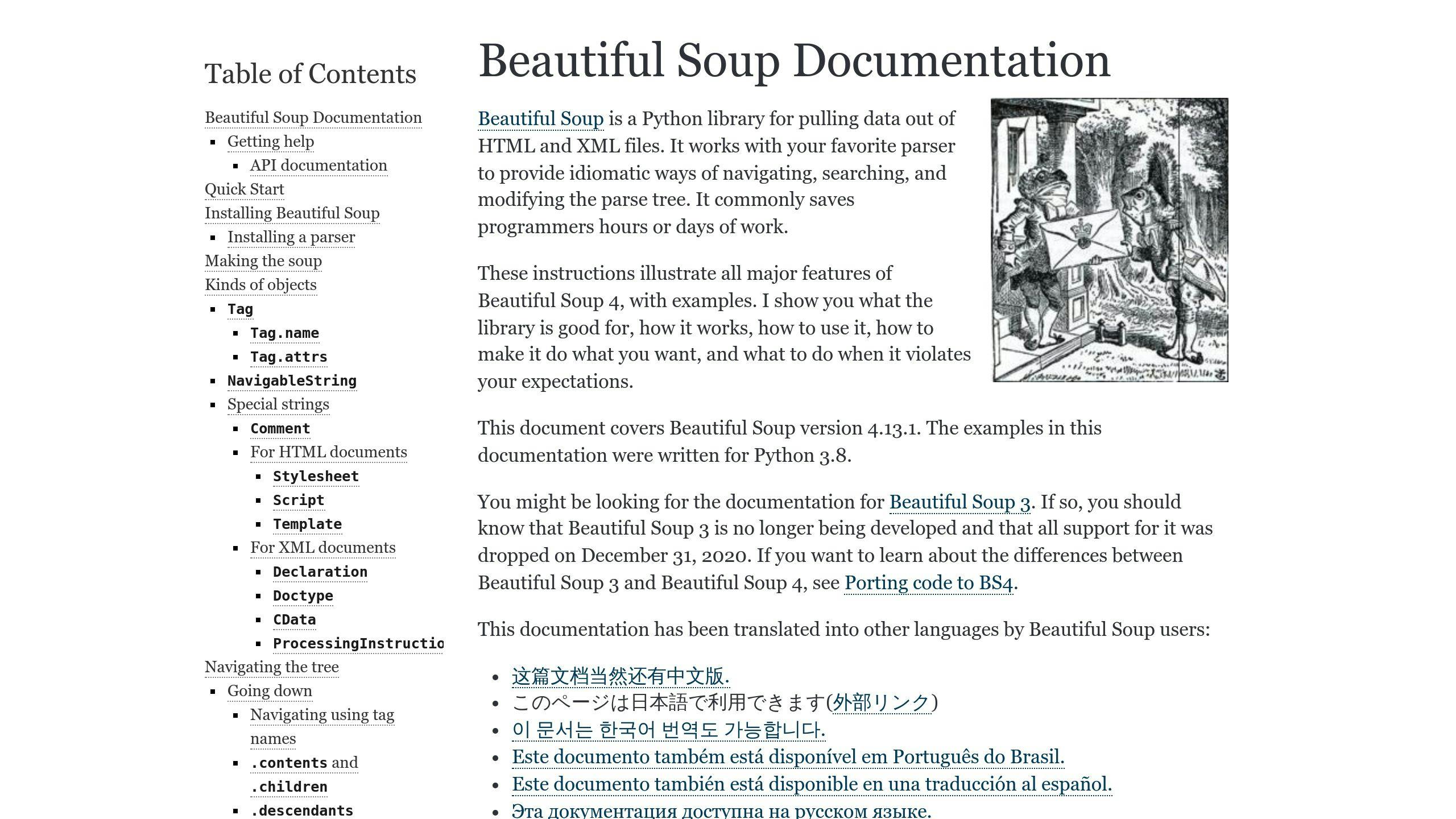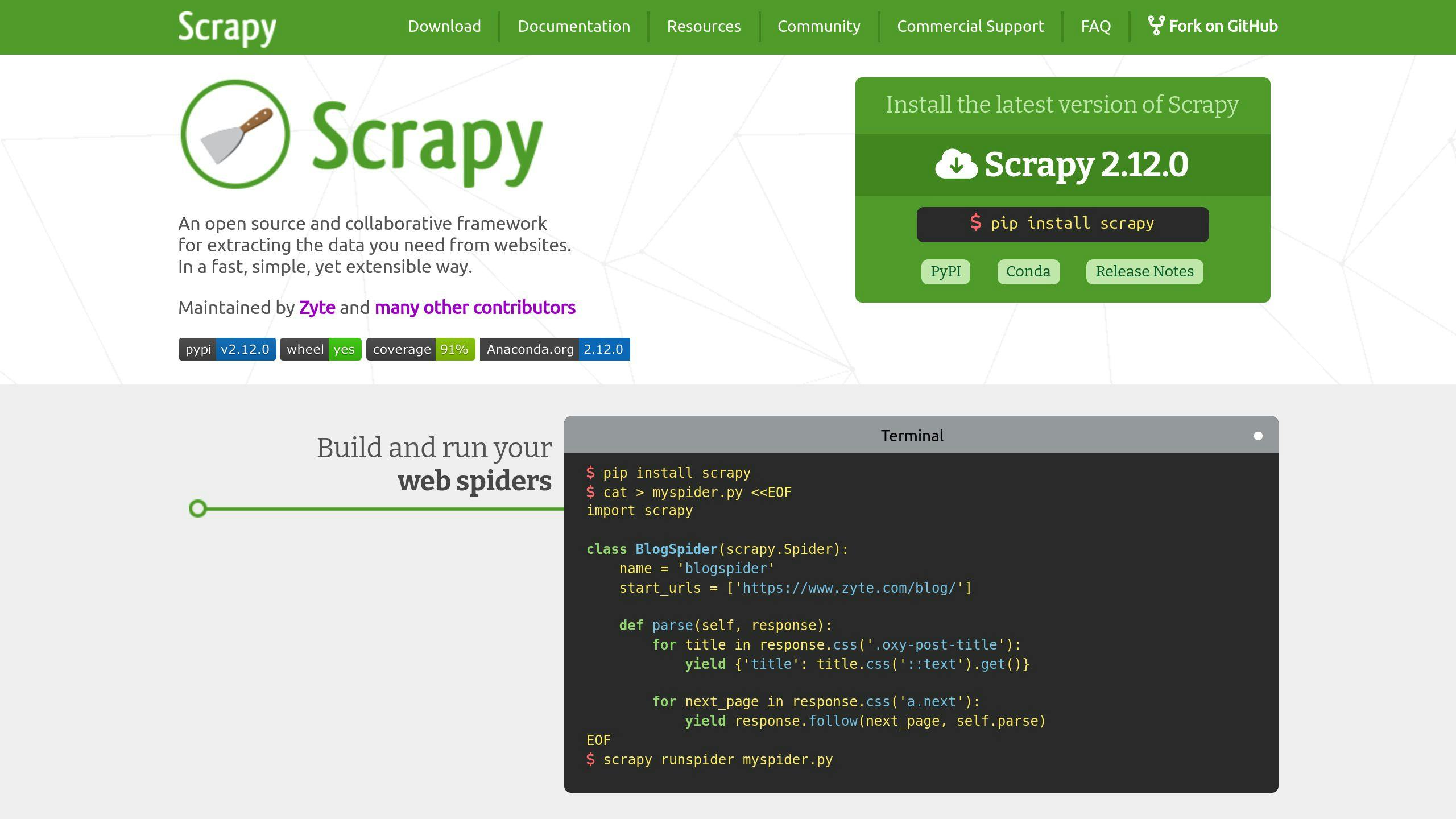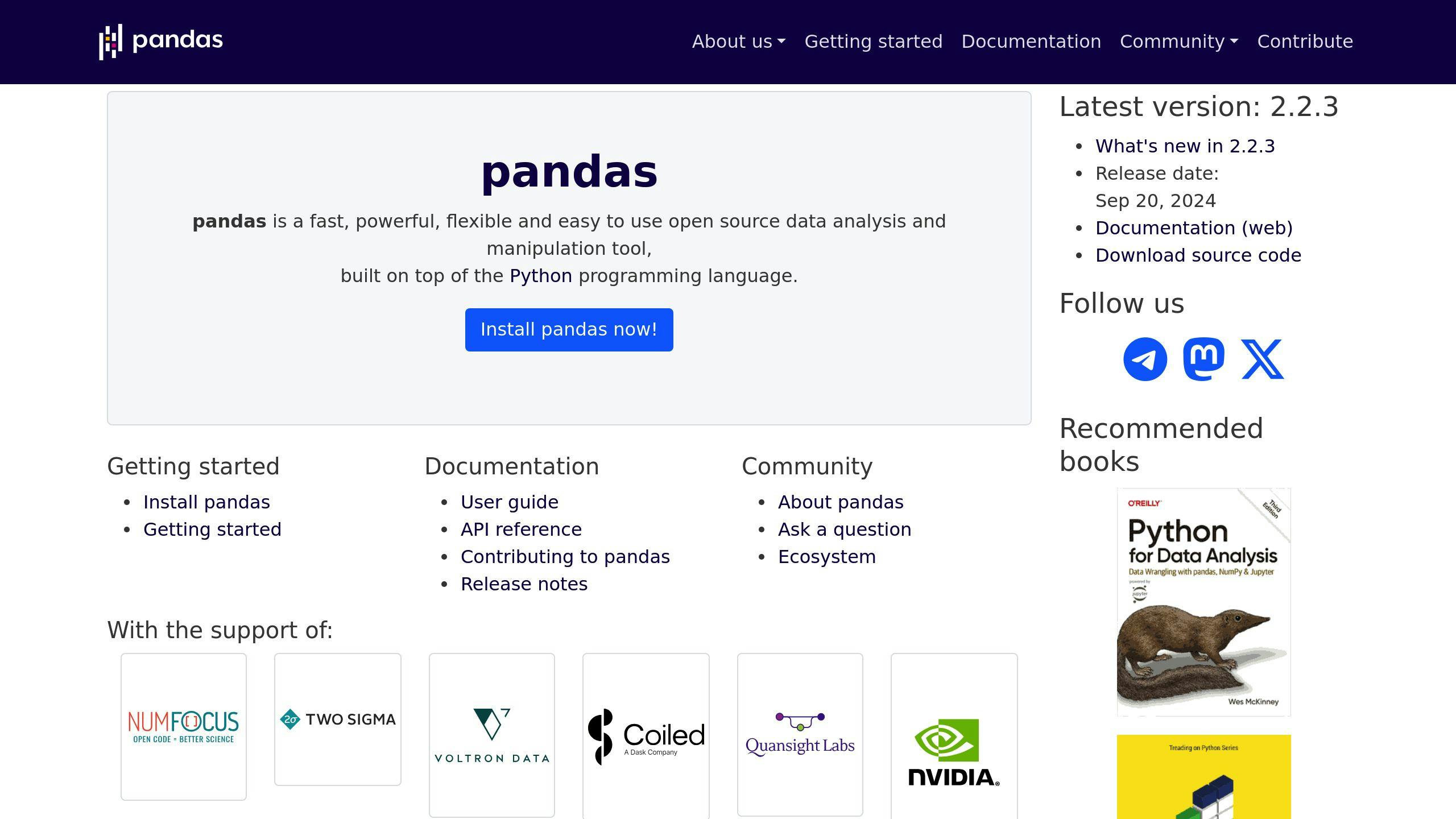Automating data extraction saves time, reduces errors, and simplifies complex workflows. Python is a top choice for this, offering tools like BeautifulSoup for small-scale scraping, Scrapy for large-scale projects, and pandas for processing data. Here's what you'll learn:
- Why Python?: Simple syntax, powerful libraries, and scalability.
- Key Tools:
- BeautifulSoup: Best for parsing static HTML.
- Scrapy: Handles large, asynchronous scraping projects.
- pandas: Cleans and organizes data for analysis.
- How to Start:
- Set up a Python environment with virtual environments and libraries.
- Use BeautifulSoup for simple scraping or Scrapy for advanced workflows.
- Automate and schedule tasks with tools like
scheduleor Airflow.
Python makes every step of data extraction - from fetching to cleaning to integrating - efficient and reliable. Whether you're scraping a single page or managing a large dataset, Python has the tools you need.
Preparing Your Python Environment
Setting up your Python environment properly is key to ensuring your data extraction workflows run smoothly. A well-organized setup helps your scripts handle the demands of automation tasks without hiccups. Using Python 3.12.0 is recommended for the best performance and compatibility with libraries.
Installing Python Libraries
Start by installing the necessary libraries with pip:
pip install beautifulsoup4 requests lxml scrapy pandas pyarrow selenium
These libraries are essential for tasks like parsing HTML, web crawling, and handling data. At the beginning of your script, import the ones you need:
from bs4 import BeautifulSoup
import requests
import pandas as pd
import scrapy
Setting Up a Virtual Environment
To avoid dependency conflicts, create a virtual environment using:
python -m venv scraping-env
Activate it with the appropriate command for your operating system:
- Windows:
activate - Unix/Linux:
source activate
This keeps your project dependencies isolated and manageable.
Development Tools and Best Practices
Use an IDE like PyCharm or VS Code to simplify debugging and take advantage of features like code completion. For faster data processing and exporting, combine pyarrow with pandas to work with formats like Parquet.
Pick the right tools for your project:
- BeautifulSoup: Ideal for small projects where simplicity is key.
- Scrapy: Perfect for larger projects that need asynchronous requests.
- pandas: Great for manipulating and analyzing datasets efficiently.
With your environment set up, you're ready to start building scripts using libraries like BeautifulSoup and Scrapy for effective data extraction.
Using BeautifulSoup for Web Scraping

BeautifulSoup is a Python library that simplifies parsing HTML and XML, making it a great choice for smaller or moderately complex web scraping tasks. It's particularly useful for extracting data from static websites or handling straightforward scraping needs.
Fetching Webpage Content
To start scraping, you first need to fetch the webpage's content. Here's how you can do it:
import requests
from bs4 import BeautifulSoup
url = 'https://news.ycombinator.com/'
response = requests.get(url)
if response.status_code == 200:
soup = BeautifulSoup(response.content, 'html.parser') # Handles webpage encoding effectively
else:
print(f"Failed to retrieve page: Status code {response.status_code}")
Parsing HTML and Extracting Information
BeautifulSoup offers simple tools to navigate and extract data from HTML. For example, you can extract article titles and links with this code:
# Locate and extract article details
articles = soup.select('div.athing span.titleline a')
for article in articles:
print(f"Title: {article.text.strip()}, Link: {article['href']}")
You can also use more specific selectors to fine-tune your data extraction:
# Use CSS selectors for precise targeting
elements = soup.select('div.story > span.titleline > a')
# Find elements with specific attributes
data = soup.find('div', attrs={'class': 'content', 'id': 'main'})
Scraping Multi-Page and Dynamic Websites
For scraping data across multiple pages, you can set up a simple pagination process:
import time
from random import randint
for page in range(1, 6):
response = requests.get(f'https://example.com/page/{page}')
time.sleep(randint(2, 5)) # Add random delays to mimic human activity and reduce server load
soup = BeautifulSoup(response.content, 'html.parser')
# Add your scraping logic here
For websites that use JavaScript to load content, you'll need to pair BeautifulSoup with Selenium for better results:
from selenium import webdriver
from selenium.webdriver.chrome.service import Service
driver = webdriver.Chrome(service=Service(ChromeDriverManager().install()))
driver.get(url)
soup = BeautifulSoup(driver.page_source, 'html.parser')
BeautifulSoup is perfect for small-scale projects, but if you're dealing with more complex scraping tasks, you might want to consider a more advanced framework like Scrapy, which we'll discuss next.
Scraping Complex Websites with Scrapy

Scrapy is a powerful tool for large-scale web scraping, especially when dealing with complex workflows. Its ability to handle numerous requests simultaneously makes it ideal for extracting data from websites efficiently.
Starting a Scrapy Project
To begin with Scrapy, you need to set up a project that organizes your spiders and configurations. Here's how to get started:
# Create a new Scrapy project
scrapy startproject ecommerce_scraper
# Generate a spider
cd ecommerce_scraper
scrapy genspider products example.com
Your spider file will look something like this:
import scrapy
class ProductsSpider(scrapy.Spider):
name = 'products'
allowed_domains = ['example.com']
start_urls = ['https://example.com/products']
def parse(self, response):
# Extract product details
products = response.css('div.product-item')
for product in products:
yield {
'name': product.css('h2.title::text').get(),
'price': product.css('span.price::text').get(),
'url': product.css('a.product-link::attr(href)').get()
}
Organizing Data with Items and Pipelines
Scrapy uses Items to structure your data and Pipelines to process it. These components work together to ensure your scraped data is clean and ready for use. Here's an example:
# items.py
class ProductItem(scrapy.Item):
name = scrapy.Field()
price = scrapy.Field()
url = scrapy.Field()
timestamp = scrapy.Field()
# pipelines.py
from datetime import datetime
class CleaningPipeline:
def process_item(self, item, spider):
item['price'] = float(item['price'].replace('$', '').strip())
item['timestamp'] = datetime.now()
return item
# settings.py
ITEM_PIPELINES = {
'ecommerce_scraper.pipelines.CleaningPipeline': 300,
}
Handling JavaScript and Other Challenges
Dynamic, JavaScript-driven websites can be tricky to scrape. Scrapy works with Splash, a lightweight browser emulator, to handle such cases:
from scrapy_splash import SplashRequest
class DynamicSpider(scrapy.Spider):
name = 'dynamic'
def start_requests(self):
urls = ['https://example.com/dynamic-content']
for url in urls:
yield SplashRequest(url, self.parse)
Additionally, you can tweak Scrapy's settings to improve performance and ensure responsible scraping:
# settings.py
CONCURRENT_REQUESTS = 16
DOWNLOAD_DELAY = 1.5
ROBOTSTXT_OBEY = True
With these tools and configurations, you can extract data efficiently, even from challenging websites. Next, we’ll dive into how to clean and format the data for further use.
Processing and Using Extracted Data
After scraping data successfully, the next steps involve cleaning, formatting, and integrating it into your workflows. Properly cleaned and formatted data ensures the information you’ve collected is ready for practical use.
Cleaning and Formatting Data with pandas

The pandas library makes it easier to clean and organize your scraped data. Here's an example of how to handle missing values, duplicates, and data types:
import pandas as pd
# Remove rows with missing values in critical columns
df = df.dropna(subset=['critical_columns'])
# Fill missing values in optional columns with default values
df = df.fillna({'optional_columns': 'default_value'})
# Remove duplicate rows based on a unique identifier
df = df.drop_duplicates(subset=['unique_identifier'])
# Convert data types for consistency
df['price'] = df['price'].astype(float)
df['date'] = pd.to_datetime(df['date'])
Saving Data in Different Formats
To ensure compatibility with various tools, export your data in formats that suit your needs. pandas supports several options:
# Save as CSV (compact and widely supported)
df.to_csv('extracted_data.csv', index=False)
# Save as JSON (ideal for web applications)
df.to_json('extracted_data.json', orient='records')
# Save as Excel (supports advanced formatting)
df.to_excel('extracted_data.xlsx', sheet_name='Extracted Data')
Integrating Data into Applications
To use your data in applications, load it into databases or APIs. Here's an example of how to integrate data into a PostgreSQL database:
from sqlalchemy import create_engine
# Establish a database connection
engine = create_engine('postgresql://user:password@localhost:5432/database')
# Write DataFrame to a SQL table
df.to_sql('extracted_data', engine, if_exists='replace', index=False)
For larger datasets, handle potential errors during insertion:
try:
df.to_sql('extracted_data', engine, if_exists='append')
except Exception as e:
print(f"Error during database insertion: {e}")
With your data cleaned, formatted, and integrated, you’re ready to streamline your workflows and make the most of the information you've gathered.
sbb-itb-f2fbbd7
Automating Data Extraction Workflows
Once you've extracted and processed your data, the next logical step is automating these workflows. Automation ensures consistent performance, reduces errors by up to 70%, and minimizes manual effort.
Combining Scripts into a Workflow
Python provides excellent tools to combine multiple scripts into smooth workflows. For simpler tasks, the subprocess module works well. For more complex workflows - like those with dependencies or advanced scheduling - Apache Airflow is a great choice. Here's how you can use both:
Using subprocess for basic automation:
import subprocess
def run_workflow():
try:
# Run the scraping script
subprocess.run(['python', 'scraper.py'], check=True)
# Process the extracted data
subprocess.run(['python', 'data_processor.py'], check=True)
# Load data into the database
subprocess.run(['python', 'database_loader.py'], check=True)
except subprocess.CalledProcessError as e:
raise
For more advanced workflows, Airflow can help:
from airflow import DAG
from airflow.operators.python_operator import PythonOperator
from datetime import datetime, timedelta
default_args = {
'owner': 'data_team',
'start_date': datetime(2025, 2, 3),
'retries': 3,
'retry_delay': timedelta(minutes=5)
}
dag = DAG('data_extraction_workflow',
default_args=default_args,
schedule_interval='@daily')
scrape_task = PythonOperator(
task_id='scrape_data',
python_callable=scrape_function,
dag=dag
)
No matter the method you choose, adding proper error handling and logging is crucial to keep workflows running smoothly.
Managing Errors and Logs
Good logging practices help you monitor and troubleshoot your workflows effectively. Here's an example of setting up logging:
import logging
from logging.handlers import RotatingFileHandler
handler = RotatingFileHandler(
'extraction_workflow.log',
maxBytes=10000000, # 10MB
backupCount=5
)
logging.basicConfig(
level=logging.INFO,
format='%(asctime)s - %(name)s - %(levelname)s - %(message)s',
handlers=[handler]
)
logger = logging.getLogger('extraction_workflow')
try:
logger.info("Data extraction started")
# ... extraction process ...
except Exception as e:
logger.error(f"Extraction failed: {str(e)}")
retry_extraction()
This setup ensures you have detailed records of your workflow's performance and any issues that arise.
Scheduling Tasks Automatically
To automate task scheduling in a platform-independent way, Python's schedule library is a simple yet effective tool:
import schedule
import time
def job():
try:
run_workflow()
except Exception as e:
print(f"Scheduled job failed: {str(e)}")
# Schedule the job to run daily at 2 AM
schedule.every().day.at("02:00").do(job)
while True:
schedule.run_pending()
time.sleep(60)
With workflows automated and tasks scheduled, you can shift your focus to analyzing the extracted data and driving insights.
Guidelines for Ethical and Scalable Data Extraction
To keep your automated workflows running smoothly and responsibly, it's important to follow ethical practices while optimizing performance. Ethical data extraction ensures a balance between efficiency and accountability, building on the scraping methods introduced with tools like BeautifulSoup and Scrapy.
Respecting Website Policies
Ethical scraping starts with adhering to website rules, such as those outlined in robots.txt files. Python's RobotFileParser can help you check permissions before scraping:
from urllib.robotparser import RobotFileParser
from urllib.parse import urlparse
def check_robots_txt(url, user_agent):
rp = RobotFileParser()
domain = urlparse(url).scheme + "://" + urlparse(url).netloc
rp.set_url(domain + "/robots.txt")
rp.read()
return rp.can_fetch(user_agent, url)
Once you've confirmed that scraping is allowed, focus on techniques that maintain efficiency while reducing the risk of detection.
Using Proxies and Rate Limiting
To scrape responsibly, it's crucial to manage your request frequency and use proxies. Here's an example of proxy rotation with rate limiting:
import requests
from time import sleep
import random
class ProxyRotator:
def __init__(self, proxy_list):
self.proxies = proxy_list
self.current = 0
def get_proxy(self):
proxy = self.proxies[self.current]
self.current = (self.current + 1) % len(self.proxies)
return proxy
def make_request(self, url):
proxy = self.get_proxy()
sleep(random.uniform(1, 3)) # Add a random delay between requests
return requests.get(url, proxies={'http': proxy, 'https': proxy})
This approach helps you avoid overwhelming servers and reduces the chances of being blocked.
Boosting Script Performance
To handle large datasets effectively, leverage tools like multiprocessing, asyncio, and caching. These techniques can significantly improve script performance:
| Technique | Best For | Performance Boost |
|---|---|---|
| Multiprocessing | CPU-heavy tasks | Up to 60% faster with parallel processing |
| Asyncio | I/O-heavy operations | Up to 10x faster for concurrent tasks |
| Intelligent caching | Frequently accessed data | 40-50% reduction in processing time |
"By carefully implementing these parallel processing techniques and following best practices, you can significantly enhance the speed and efficiency of your web scraping projects in Python." - ScrapingAnt Research Team
For massive datasets, consider using pandas' chunk processing to manage memory usage efficiently. For more details, see the earlier section on cleaning and formatting data.
Automating Data Extraction with Python
Key Takeaways
Python stands out as a powerful choice for automating data extraction tasks. Tools like BeautifulSoup and Scrapy work well together - BeautifulSoup simplifies straightforward parsing, while Scrapy is designed for more complex, large-scale data extraction. Together, they cover a wide range of data collection needs.
Here’s a quick comparison of the tools and their benefits:
| Tool | Best Use Case | Key Advantage | Typical Time Savings |
|---|---|---|---|
| BeautifulSoup | Single-page scraping | Easy to implement | 40-60% faster than manual |
| Scrapy | Large-scale projects | Built-in crawling tools | 70-85% faster than manual |
| Pandas | Data processing | Streamlined manipulation | 50-65% reduction in time |
These tools can help you save significant time and effort, making automated data extraction not just efficient but also practical for a variety of tasks.
How to Start Automating
- Define Your Goals: Clearly outline what data you need and select the right tool. Use BeautifulSoup for simpler tasks and Scrapy for handling larger, more complex projects.
- Build Step by Step: Begin with small scripts and expand gradually. Incorporate error handling, logging, and rate limiting to ensure your workflow is reliable. Tools like APScheduler can help with scheduling and monitoring tasks effectively.
FAQs
Which is better, Scrapy or BeautifulSoup?
The choice between Scrapy and BeautifulSoup depends on what your project needs. Here's a quick comparison to guide you:
| Feature | Scrapy | BeautifulSoup |
|---|---|---|
| Best Use Case | Large-scale web scraping | Simple HTML/XML parsing |
| Performance | High-speed (async requests) | Standard speed |
| Built-in Crawling | Yes | No |
| Proxy Support | Built-in | Requires extra libraries |
| Project Scale | Enterprise-level projects | Small to medium projects |
Scrapy is great for large-scale tasks, such as scraping e-commerce sites with thousands of pages. Its asynchronous processing and built-in crawling make it a powerful choice. On the other hand, BeautifulSoup works well for smaller projects or static pages that don't require heavy automation.
If you need JavaScript rendering, Scrapy can integrate with tools like Selenium or Scrapy-Splash. BeautifulSoup, however, depends on external libraries like requests-html for similar tasks. Many developers even combine Scrapy's crawling capabilities with BeautifulSoup's parsing for more precise data extraction.
Pro Tip: Start with BeautifulSoup for simpler tasks or early development. As your project grows and demands more advanced automation, transitioning to Scrapy can save time and effort.
Knowing the strengths of each tool helps you make smarter choices and optimize your data scraping process.


